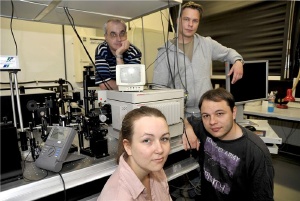Jul 9 2009
For more than 100 years it has been known that light comes in small packages, the so-called photons. The discovery of this quantization of the light field has opened up a new field of physics - quantum optics. In the sixties one of its pioneers, the Nobel Prize winner Roy Glauber, suggested to characterize light sources according to the sequence of their emitted photons. But the realization of this idea has been very limited up to now. In modern lasers the light emission can take place within a picosecond, a 1000 times faster than has ever been detected before in photon sequence measurements. A team at the Faculty of Physics at TU Dortmund with Prof. Manfred Bayer in charge made a major breakthrough in cooperation with their colleagues from Bremen and Würzburg: in several years of work the worldwide first detector has been developed which has the necessary temporal resolution.
 Prof. Manfred Bayer, Franziska Veit, Thorsten Berstermann and Marc Assmann
Prof. Manfred Bayer, Franziska Veit, Thorsten Berstermann and Marc Assmann
At first the detector was able to show that light has the statistic characteristics which Roy Glauber theoretically predicted. For this purpose a common laser structure was stimulated to emit light. When the stimulation is low the structure still emits classic light. But when the stimulation is stronger the laser crosses its threshold and starts to emit laser light. The experimentally detected sequence of photons clearly substantiated that.
During their examinations of miniaturized lasers the Dortmund physicists Marc Assmann, Thorsten Berstermann, Franziska Veit and Manfred Bayer obtained surprising results.
One of the goals of the intensive worldwide efforts concerning the miniaturization of lasers is the realization of a thresholdless laser which can convert power entirely into laser light. That would be a very energy-efficient method. For their examinations the Dortmund team had miniaturized lasers from Würzburg and Bremen available. These lasers are result of cutting-edge technology and come already close to thresholdless lasers.
They pushed such lasers across the threshold and the detector showed that the sequence of two photons does not change from classic light to laser light, as expected. At this crossover rather quantum light emission occurred: the photons avoid each other, i.e. the probability to find two photons in direct succession is reduced compared to big displacement times. In the case of laser light, on the other hand, all random temporal delays between two photons are equally probable, while in case of classic light the photons preferentially arrive together.
When the Dortmund physicists presented their results to their Bremen project partners, who develop elaborate theoretical models for describing such lasers, they could hardly believe it but immediately started modeling the experimental data. And in fact, the model calculations confirmed the results. Moreover, oscillations in the probability to find two photons with a certain temporal displacement were predicted which could experimentally be totally confirmed. Certain displacements, causing quantum light emissions, are more likely than others.
This behavior can qualitatively be understood as follows: the laser can roughly be compared with the starship Enterprise which has two drive modes: the normal rocket propulsion and the Warp-drive. The rocket propulsion is equivalent to the emission of classic light beneath the threshold. The Warp-drive is equivalent to the laser operation. When one wants to switch from classic to Warp and does not produce enough propulsion, the power unit starts to splutter and the Enterprise hops through space – the final frontier. The oscillations which can be observed in the photon statistic of the miniaturized lasers are very similar: the laser jumps in its emission characteristics. Only when there is enough propulsion, there is regular laser operation.
This work was enabled by the generous funding of the Deutsche Forschungsgemeinschaft and was published in the latest edition of Nature.